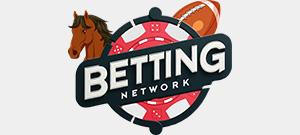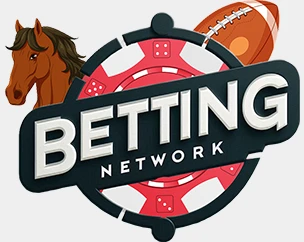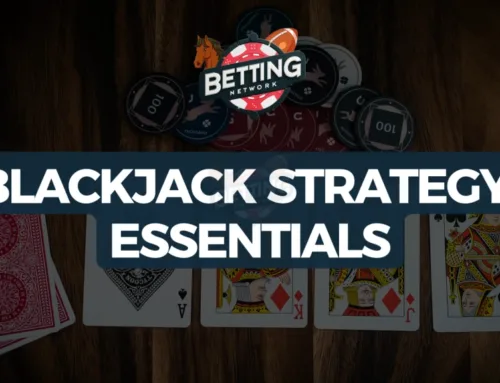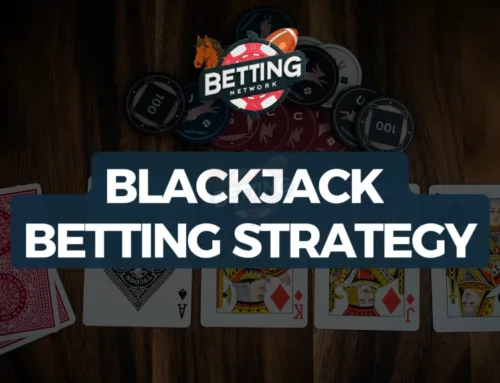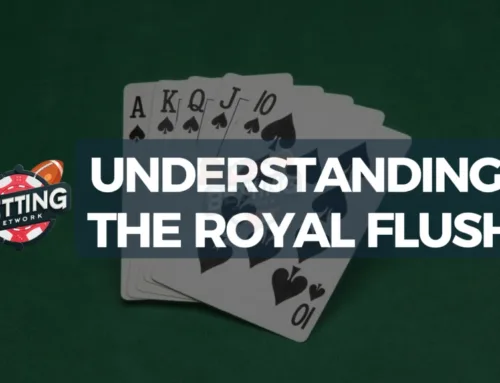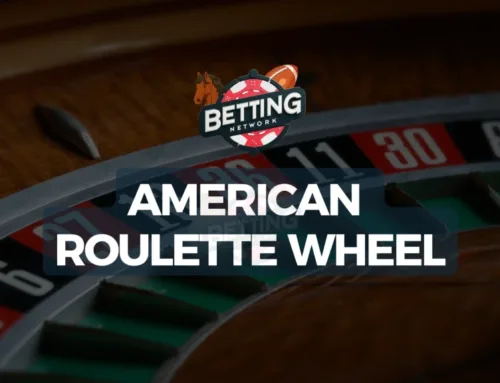People that learn how to play craps all say the same: it’s a game that’s easy to learn, but hard to master. I’d say that’s precisely what makes it fun: anyone can pick it up within a matter of minutes, but getting good at it? That’s open to anyone who enjoys games with a mix of strategy (and a good thrill).
The core of the game revolves around rolling a pair of dice, while players bet on the outcome of the dice roll. You’ll find all sorts of betting options: bets that appeal to risk-adverse players and high-stakes, high-payout strategies that gamblers love.
How to Play Craps: Win Conditions and Terms
Anyway, let’s take a look at some of the basic terms you’ll need to know to understand the action at the table.
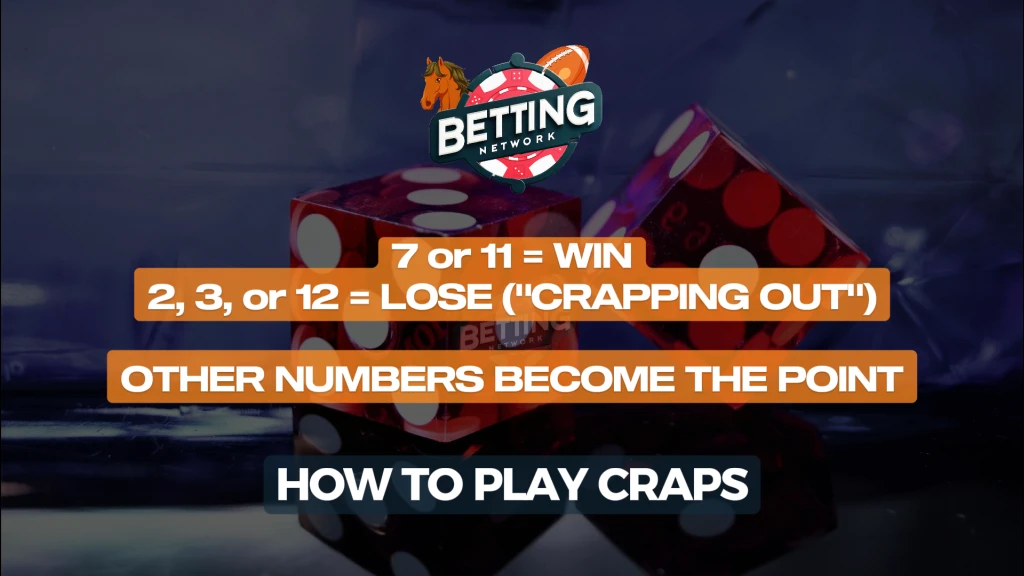
How to Play Craps: The Come-Out Roll
The come-out roll is the first roll of the dice in a round of Craps. It’s crucial because it determines whether the game continues with a point or ends immediately with a win or loss.
The come-out roll is the first roll of the dice in a round of Craps, and it determines whether the game continues with a point of ends immediately with a win or a loss. If the come-out roll is:
- A 7 or 11, players with a pass line bet win
- A 2, 3, or 12, pass line bettors lose (this is called “crapping out”)
- Any other number (4, 5, 6, 8, 9, or 10) becomes the point
Ending the Round
A round of craps ends whenever a 7 is rolled before the point, or when the point is rolled again. Once the round ends, the dice move to a new shooter, and a new round begins with another come-out roll. This tends to happen fairly often, so the game itself is perfect for players that love fast-paced action.
Just to recap:
- The game starts with a come-out roll. Players bet on whether the shooter will win or lose immediately.
- The point is the number the shooter aims to roll again before rolling a 7.
- A seven-out means the shooter loses, and the round ends.
Like I mentioned earlier, you can bet on all sorts of outcomes and this add tremendous depth to craps betting in general. Once you learn how to play Craps, you’ll realize just how many different bets you can take before the dices even start flying!
Types of Bets in Craps
Understanding craps bets is an essential part of knowing how to play craps. There are simple bets and increasingly more complex options that can significantly enhance your chances of winning, so let’s go over each of them.
Pass Line Bet and Don’t Pass Bet
The pass line bet is the most common and straightforward bet in Craps, so it’s usually where beginners see most of their action. It’s an excellent bet for those learning how to play craps since it’s placed before the come-out roll. Basically, you wager on whether the shooter will win or not.
Here are the win conditions and other possible outcomes:
Pass Line Bet
- You win if the shooter rolls a 7 or 11 on the come-out roll.
- You lose if the shooter rolls a 2, 3, or 12.
If you roll any other number is rolled (4, 5, 6, 8, 9, or 10), that number becomes the point, and the shooter must roll the point again before rolling a 7.
Don’t Pass Bet
- You win if the shooter rolls a 2 or 3 on the come-out roll.
- Rolling a 12 is a push (neither win nor lose).
- You lose if the shooter rolls a 7 or 11.
If a point is established, you win if a 7 is rolled before the point.
Come Bet and Don’t Come Bet
These bets are similar to the pass line and don’t pass line bets, but these are placed after the come-out roll. These bets allow players to join the action at any point. Let’s go over how you can or lose with these bets.
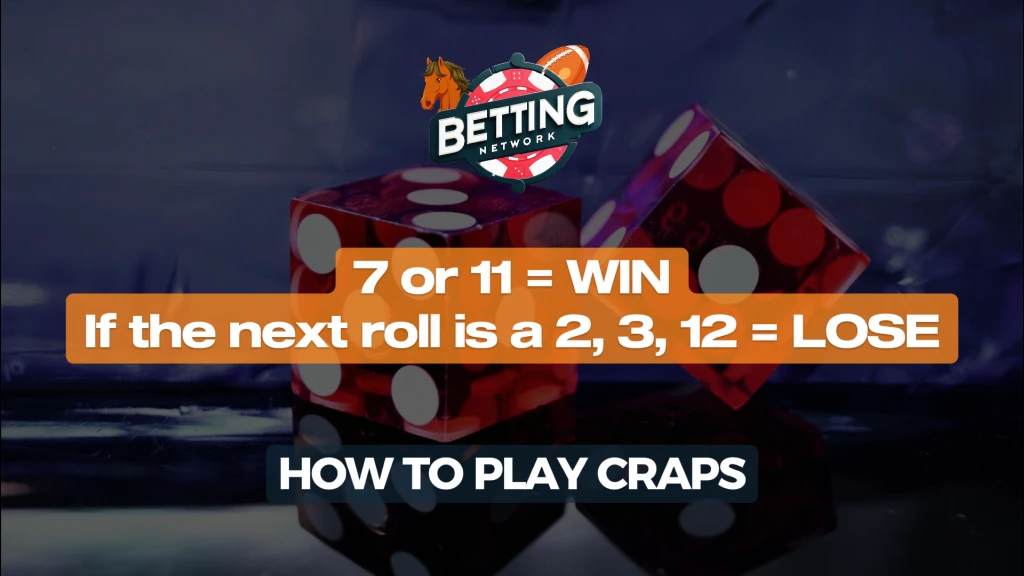
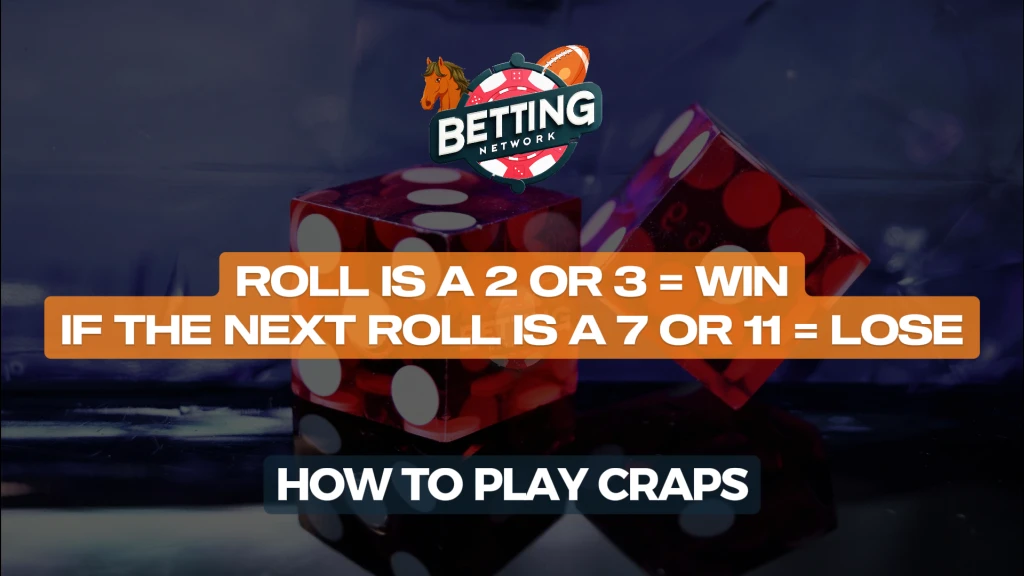
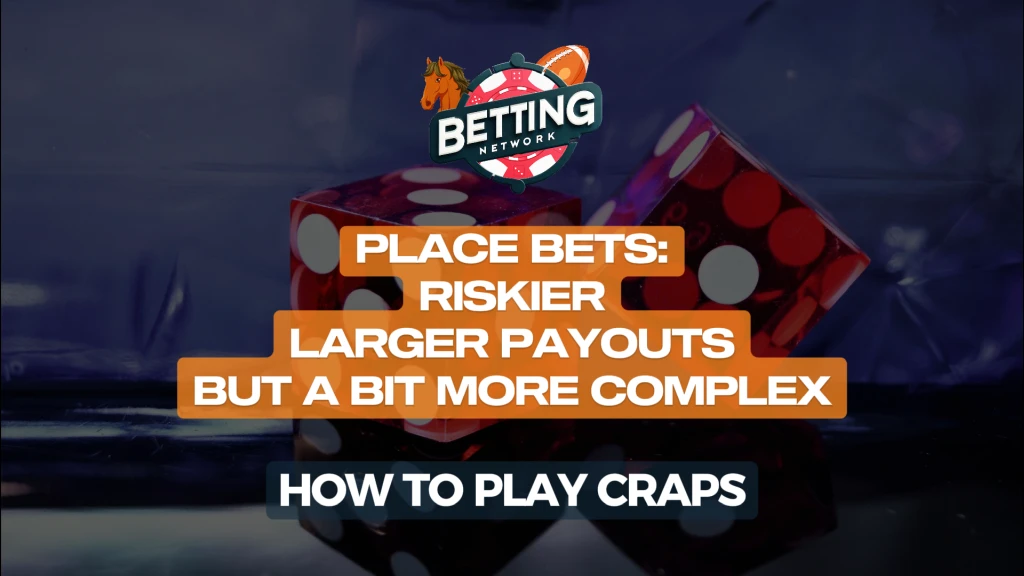
Place Bets
Place bets allow you to bet on the shooter rolling the numbers 4, 5, 6, 8, 9, or 10 before a 7. You can make these bets at any time, meaning they’re not restricted to the pass or don’t pass sequence.
Field Bets and Proposition Bets
These are riskier bets with larger payouts, and they’re also a bit more complex bet. Typically, not recommended for beginners that want to learn how to play Craps.
Field bets are also one-roll bet where you win if a 2, 3, 4, 9, 10, 11, or 12 is rolled. Most of these pay even money, but a 2 and 12 often pay double or triple, so you can already tell why they’re popular. It’s an easy bet with low risk, but it only covers one roll.
Proposition bets are one-roll bets that sit in the middle of the table. You can bet on things like “any craps” (2, 3, or 12), a specific number (like betting a hard 6 or hard 8), or “any 7.” Naturally, the odds aren’t as great, but the payouts more than make up for that. It’s your typical high-risk, high-reward casino bet.
You can bet on a specific number being rolled (e.g., 2, 3, 7, 11, or 12). Naturally the odds aren’t as great, but the payouts more than make up for that. Think of Field Bets as safer, simpler bets with lower payouts, and Proposition Bets as high-risk, high-reward bets that can yield big paydays.
What are Hardways?
A hardway bet is when you predict that the dice will land on a pair of identical numbers. For example, a 4-4 would be a “hard 8”, and a 3-3 would be a “hard 6”. It’s called “hard” because it’s harder to roll doubles than any other combination that adds up to that total, so an “easy 8” would be something like a 5-3 or 6-2.
Hardways have big payouts, but they’re risky. The odds aren’t in your favor, so it’s more of a fun side bet rather than something to rely on for steady winnings. I wouldn’t recommend this for beginners, unless you’re just having fun or it’s part of a bigger strategy.
How to Play Craps: Table Layout
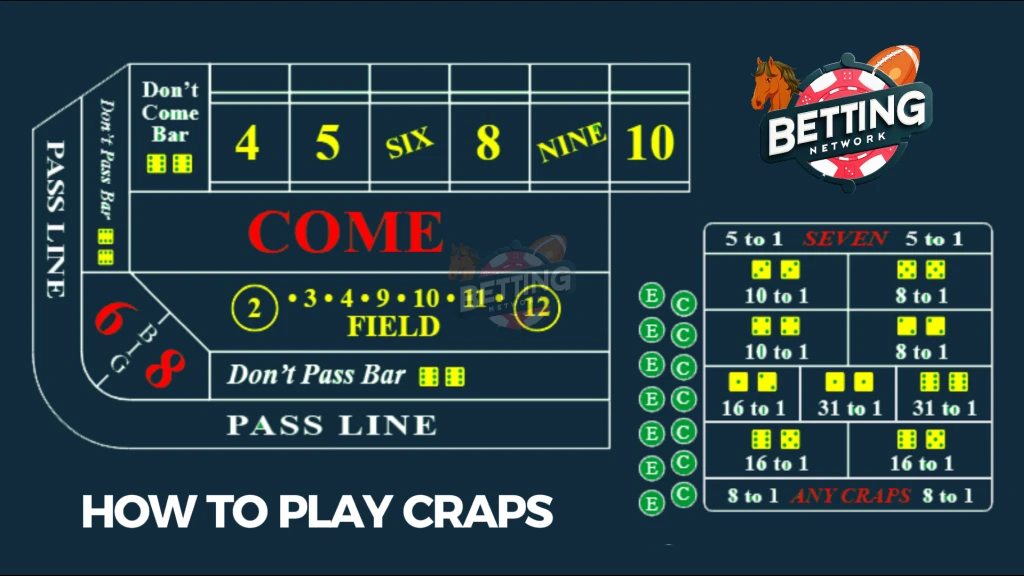
The Craps table is big and can feel intimidating at first, but once you break it down, it’s not so bad. I’ll walk you through it like we’re just hanging out at a table.
The Pass Line
This is where players place their most common bets. It runs along the outer edge, and when you bet here, you’re betting that the shooter (the person rolling the dice) will win by rolling a 7 or 11 on their first roll. You can also win when the shooter makes the point, which is rolling a specific number twice before hitting a 7.
The Don’t Pass Line
This is the opposite of the pass line, and it’s right next to it. Here, you can bet that the shooter will lose by rolling a 2, 3, or 12 on the come-out roll or that they won’t hit the point. That’s right, you can bet for or against the shooter!
The Come and Don’t Come Section
This section is located in the middle of the layout and they let you start a “new game” mid-round. These spots are similar to the pass and don’t pass bets, but you can place these after the point is set.
Odds Area
Once the point is set, you can place an odds bet behind your pass line or come bets. Here, you can take advantage of those juicy zero-house-edge bets that you always hear about!
Place Bets Area
Here you can bet on 4, 5, 6, 8, 9, 10 to appear before a 7.
Field Bets Area
It’s the section with the huge “Field” on the layout, so you can’t miss it. Here, you can predict on a 2, 3, 4, 9, 10, 11, or 12 being rolled on the next toss.
Big 6 and Big 8 Area
These are marked as big numbers in the corners. Here, you can bet that a 6 or 8 will be rolled before a 7. You can place the same bet in a better way elsewhere so I don’t see this used often.
Proposition Bets
Here you can bet on a specific number, like 2 (Snake Eyes) or 12 (Boxcars) and boy do they pay big if you hit. The odds aren’t exactly in your favor though, so you should avoid this section as a beginner.
Horn Bets
This is a bet on the 2, 3, 11, or 12 all at once. You’ll see it grouped with the proposition bets. Another risky area that isn’t beginner-friendly.
The best bets for beginners are on the outer edges (pass line, don’t pass, come, don’t come). You can make your way to the middle once you’re more experienced at craps, but be ready for the house edge to creep up on you.
How to Play Craps: Strategies and Tips
This is where you’ll find the real depth behind the game, and where min-maxers thrive. I’ve written a whole article dedicated to the best strategy for craps, covering beginner-friendly strategies that allow you to extend your bankroll, as well as some high-octane strategies that risk takers will love to try!
For now, I’ll stick to some of the more beginner-friendly strategies and useful starters tips I wish I’d gotten when I first started playing. I’ll also include a couple of intermediate-level strategies for craps, but I’d highly recommend checking out our other piece for more in-depth stuff!
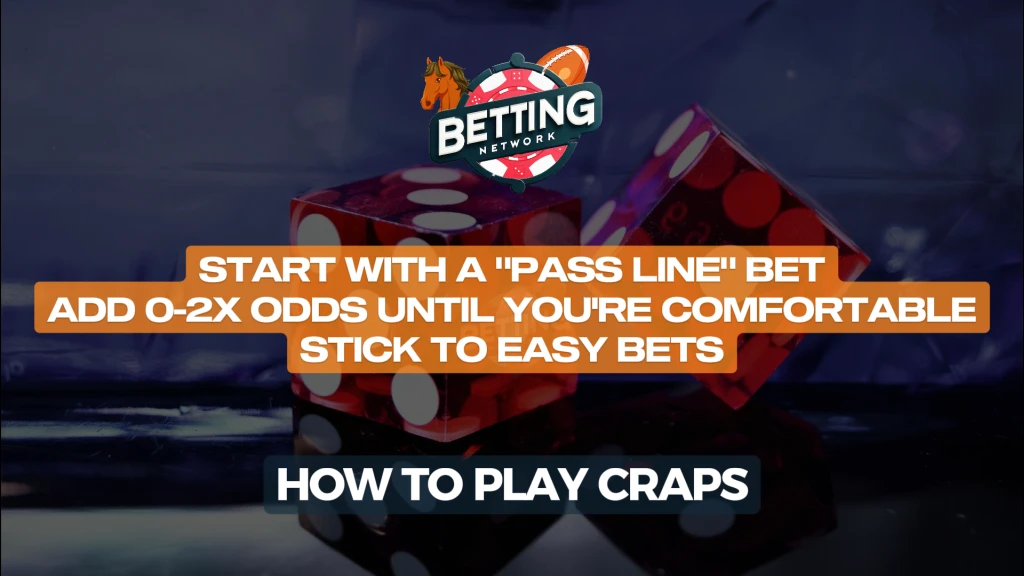
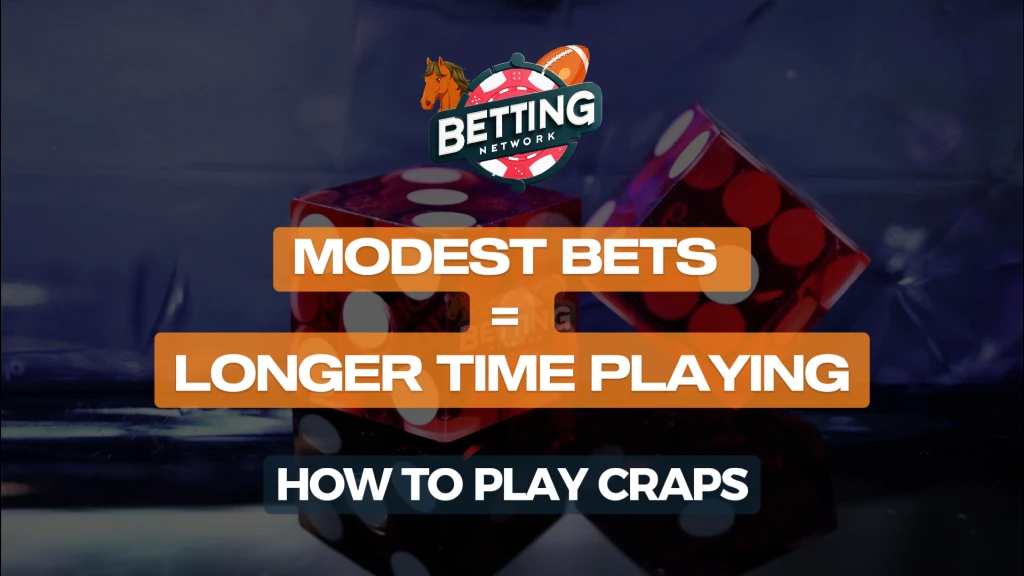
The Slow Roller Craps Strategy
Imagine that your friends invite you to play some craps and you’re worried of being the first person to run out of money. As a beginner, this is a valid concern, since you’re not precisely an expert at bankroll management and playing safe bets. If you can relate, then The Slow Roller strategy is perfect for you!
Basically, this strategy aims to extend your stay at the table for as long as possible, for a modest investment of course. Your payouts will come through Hardway bets, since you’re constantly re-upping Hardway bets and placing moderate bets on 6 and 8. We’re looking to:
- Build up winnings incrementally through easy wins (common rolls of 6/8).
- Capitalize on rare hard numbers, which have higher payouts.
- Stretch your bankroll to last longer in the game while building comp points.

The Vahn’s 4/10 Strategy for Craps
The Vahn’s 4/10 Strategy for craps starts with low-risk, high-reward outside bets on 4 and 10, and then quickly switches to inside numbers once you’ve recovered your initial investment. You can make back your $10 with just one hit on the 4 or 10, giving you more flexibility to cover the inside numbers for free.
This strategy capitalizes on the fact that 4 and 10 are more likely to hit than multiple hits on 6 and 8. It’s an underrated fact you’d do well to pick up early on your craps gaming career. Once you’re inside and free-rolling, the power press strategy allows you to gradually increase your bets on inside numbers to maximize winnings at lower risks.
Bonus Beginner Tip 1: Play it Safe, Learn the Ropes
If you’re new to the game, I highly recommend that you stick to bets with the lowest house edge. Pass Line and Come Bets are notorious for their odds (House Edge is around 1.41%) and they’re also fairly straightforward to play.
Bonus Beginner Tip 2: Bet on Pass!
Alright, hear me out: yes, the odds are slightly better on “don’t pass” bets, but you don’t want to be the table’s killjoy for slightly better odds! People that bet on “don’t” are sometimes seen as the “enemy” and they might even accuse you of cursing the table!
If you bet on “Pass” with the rest, though, you get to be part of the fun and celebration when a win hits! This is a deeply atmospheric kind of game, it’s a unique casino experience (especially when you compare it to Poker) because you’re all in it together to win. As a beginner, you want to be a part of this, and a tiny bump in the odds is just not worth it.
Once you’re a veteran, you can judge shooters and bet against them if you’d like, but no need to potentially have a negative experience when you’re still a newbie.
Bonus Beginner Tip 3: Learn Bankroll Fundamentals
This is absolutely essential for any type of gambling on casino games or even sports betting. If you’re good at setting clear limits, then you’re setting yourself up for long-term success.
Divide your Bankroll into Betting Units
Betting units are typically around 1-2% of your whole bankroll, and you can commit only a few units at a time on any bet. This works for most forms of gambling, so get used to thinking of your money into these small units.
Learn a Win and Stop Loss
Learning when to walk away while you’re ahead, and knowing when it’s time to call it a night before you chase losses is absolutely critical.
Beginner Tip 4: Try new Craps Strategies
We got a whole guide on beginner, intermediate and advanced Craps Strategies that you can use the next time you grab a couple of dices. We did a step-by-step breakdown of these strategies so you can see how they’d work on a real (or digital) table, and whether they’re a good fit for you and your bankroll.
You’ll also learn new bets while you’re incorporating these strategies into your toolkit, so it’s a win/win situation. Grab a cup of coffee and be sure to check them out after this!
How to Play Craps FAQ
What is the Safest Bet in Craps?
The safest bet in Craps is the pass line bet. This bet has one of the lowest house edges, sitting at around 1.41%, making it a good choice for beginners and experienced players alike.
Can You Make a Living Playing Craps?
While it’s possible to win money playing Craps, making a consistent living from it is extremely difficult due to the house edge. Gambling should be seen as a form of entertainment rather than a reliable income source.
What Does ‘Seven-Out’ Mean in Craps?
A seven-out occurs when the shooter rolls a 7 after the point has been established. This means the shooter loses control of the dice, and the round ends. All pass line bets lose, and the next player becomes the shooter.
How Do I Get Better at Craps?
To improve at Craps, it’s essential to learn the different types of bets, understand the odds, and develop a solid betting strategy. Focusing on bets with a lower house edge, like the pass line or place bets, can also improve your chances of success.
People that learn how to play craps all say the same: it’s a game that’s easy to learn, but hard to master. I’d say that’s precisely what makes it fun: anyone can pick it up within a matter of minutes, but getting good at it? That’s open to anyone who enjoys games with a mix of strategy (and a good thrill).
The core of the game revolves around rolling a pair of dice, while players bet on the outcome of the dice roll. You’ll find all sorts of betting options: bets that appeal to risk-adverse players and high-stakes, high-payout strategies that gamblers love.
How to Play Craps: Win Conditions and Terms
Anyway, let’s take a look at some of the basic terms you’ll need to know to understand the action at the table.

How to Play Craps: The Come-Out Roll
The come-out roll is the first roll of the dice in a round of Craps. It’s crucial because it determines whether the game continues with a point or ends immediately with a win or loss.
The come-out roll is the first roll of the dice in a round of Craps, and it determines whether the game continues with a point of ends immediately with a win or a loss. If the come-out roll is:
- A 7 or 11, players with a pass line bet win
- A 2, 3, or 12, pass line bettors lose (this is called “crapping out”)
- Any other number (4, 5, 6, 8, 9, or 10) becomes the point
Ending the Round
A round of craps ends whenever a 7 is rolled before the point, or when the point is rolled again. Once the round ends, the dice move to a new shooter, and a new round begins with another come-out roll. This tends to happen fairly often, so the game itself is perfect for players that love fast-paced action.
Just to recap:
- The game starts with a come-out roll. Players bet on whether the shooter will win or lose immediately.
- The point is the number the shooter aims to roll again before rolling a 7.
- A seven-out means the shooter loses, and the round ends.
Like I mentioned earlier, you can bet on all sorts of outcomes and this add tremendous depth to craps betting in general. Once you learn how to play Craps, you’ll realize just how many different bets you can take before the dices even start flying!
Types of Bets in Craps
Understanding craps bets is an essential part of knowing how to play craps. There are simple bets and increasingly more complex options that can significantly enhance your chances of winning, so let’s go over each of them.
Pass Line Bet and Don’t Pass Bet
The pass line bet is the most common and straightforward bet in Craps, so it’s usually where beginners see most of their action. It’s an excellent bet for those learning how to play craps since it’s placed before the come-out roll. Basically, you wager on whether the shooter will win or not.
Here are the win conditions and other possible outcomes:
Pass Line Bet
- You win if the shooter rolls a 7 or 11 on the come-out roll.
- You lose if the shooter rolls a 2, 3, or 12.
If you roll any other number is rolled (4, 5, 6, 8, 9, or 10), that number becomes the point, and the shooter must roll the point again before rolling a 7.
Don’t Pass Bet
- You win if the shooter rolls a 2 or 3 on the come-out roll.
- Rolling a 12 is a push (neither win nor lose).
- You lose if the shooter rolls a 7 or 11.
If a point is established, you win if a 7 is rolled before the point.
Come Bet and Don’t Come Bet
These bets are similar to the pass line and don’t pass line bets, but these are placed after the come-out roll. These bets allow players to join the action at any point. Let’s go over how you can or lose with these bets.



Place Bets
Place bets allow you to bet on the shooter rolling the numbers 4, 5, 6, 8, 9, or 10 before a 7. You can make these bets at any time, meaning they’re not restricted to the pass or don’t pass sequence.
Field Bets and Proposition Bets
These are riskier bets with larger payouts, and they’re also a bit more complex bet. Typically, not recommended for beginners that want to learn how to play Craps.
Field bets are also one-roll bet where you win if a 2, 3, 4, 9, 10, 11, or 12 is rolled. Most of these pay even money, but a 2 and 12 often pay double or triple, so you can already tell why they’re popular. It’s an easy bet with low risk, but it only covers one roll.
Proposition bets are one-roll bets that sit in the middle of the table. You can bet on things like “any craps” (2, 3, or 12), a specific number (like betting a hard 6 or hard 8), or “any 7.” Naturally, the odds aren’t as great, but the payouts more than make up for that. It’s your typical high-risk, high-reward casino bet.
You can bet on a specific number being rolled (e.g., 2, 3, 7, 11, or 12). Naturally the odds aren’t as great, but the payouts more than make up for that. Think of Field Bets as safer, simpler bets with lower payouts, and Proposition Bets as high-risk, high-reward bets that can yield big paydays.
What are Hardways?
A hardway bet is when you predict that the dice will land on a pair of identical numbers. For example, a 4-4 would be a “hard 8”, and a 3-3 would be a “hard 6”. It’s called “hard” because it’s harder to roll doubles than any other combination that adds up to that total, so an “easy 8” would be something like a 5-3 or 6-2.
Hardways have big payouts, but they’re risky. The odds aren’t in your favor, so it’s more of a fun side bet rather than something to rely on for steady winnings. I wouldn’t recommend this for beginners, unless you’re just having fun or it’s part of a bigger strategy.
How to Play Craps: Table Layout

The Craps table is big and can feel intimidating at first, but once you break it down, it’s not so bad. I’ll walk you through it like we’re just hanging out at a table.
The Pass Line
This is where players place their most common bets. It runs along the outer edge, and when you bet here, you’re betting that the shooter (the person rolling the dice) will win by rolling a 7 or 11 on their first roll. You can also win when the shooter makes the point, which is rolling a specific number twice before hitting a 7.
The Don’t Pass Line
This is the opposite of the pass line, and it’s right next to it. Here, you can bet that the shooter will lose by rolling a 2, 3, or 12 on the come-out roll or that they won’t hit the point. That’s right, you can bet for or against the shooter!
The Come and Don’t Come Section
This section is located in the middle of the layout and they let you start a “new game” mid-round. These spots are similar to the pass and don’t pass bets, but you can place these after the point is set.
Odds Area
Once the point is set, you can place an odds bet behind your pass line or come bets. Here, you can take advantage of those juicy zero-house-edge bets that you always hear about!
Place Bets Area
Here you can bet on 4, 5, 6, 8, 9, 10 to appear before a 7.
Field Bets Area
It’s the section with the huge “Field” on the layout, so you can’t miss it. Here, you can predict on a 2, 3, 4, 9, 10, 11, or 12 being rolled on the next toss.
Big 6 and Big 8 Area
These are marked as big numbers in the corners. Here, you can bet that a 6 or 8 will be rolled before a 7. You can place the same bet in a better way elsewhere so I don’t see this used often.
Proposition Bets
Here you can bet on a specific number, like 2 (Snake Eyes) or 12 (Boxcars) and boy do they pay big if you hit. The odds aren’t exactly in your favor though, so you should avoid this section as a beginner.
Horn Bets
This is a bet on the 2, 3, 11, or 12 all at once. You’ll see it grouped with the proposition bets. Another risky area that isn’t beginner-friendly.
The best bets for beginners are on the outer edges (pass line, don’t pass, come, don’t come). You can make your way to the middle once you’re more experienced at craps, but be ready for the house edge to creep up on you.
How to Play Craps: Strategies and Tips
This is where you’ll find the real depth behind the game, and where min-maxers thrive. I’ve written a whole article dedicated to the best strategy for craps, covering beginner-friendly strategies that allow you to extend your bankroll, as well as some high-octane strategies that risk takers will love to try!
For now, I’ll stick to some of the more beginner-friendly strategies and useful starters tips I wish I’d gotten when I first started playing. I’ll also include a couple of intermediate-level strategies for craps, but I’d highly recommend checking out our other piece for more in-depth stuff!


The Slow Roller Craps Strategy
Imagine that your friends invite you to play some craps and you’re worried of being the first person to run out of money. As a beginner, this is a valid concern, since you’re not precisely an expert at bankroll management and playing safe bets. If you can relate, then The Slow Roller strategy is perfect for you!
Basically, this strategy aims to extend your stay at the table for as long as possible, for a modest investment of course. Your payouts will come through Hardway bets, since you’re constantly re-upping Hardway bets and placing moderate bets on 6 and 8. We’re looking to:
- Build up winnings incrementally through easy wins (common rolls of 6/8).
- Capitalize on rare hard numbers, which have higher payouts.
- Stretch your bankroll to last longer in the game while building comp points.

The Vahn’s 4/10 Strategy for Craps
The Vahn’s 4/10 Strategy for craps starts with low-risk, high-reward outside bets on 4 and 10, and then quickly switches to inside numbers once you’ve recovered your initial investment. You can make back your $10 with just one hit on the 4 or 10, giving you more flexibility to cover the inside numbers for free.
This strategy capitalizes on the fact that 4 and 10 are more likely to hit than multiple hits on 6 and 8. It’s an underrated fact you’d do well to pick up early on your craps gaming career. Once you’re inside and free-rolling, the power press strategy allows you to gradually increase your bets on inside numbers to maximize winnings at lower risks.
Bonus Beginner Tip 1: Play it Safe, Learn the Ropes
If you’re new to the game, I highly recommend that you stick to bets with the lowest house edge. Pass Line and Come Bets are notorious for their odds (House Edge is around 1.41%) and they’re also fairly straightforward to play.
Bonus Beginner Tip 2: Bet on Pass!
Alright, hear me out: yes, the odds are slightly better on “don’t pass” bets, but you don’t want to be the table’s killjoy for slightly better odds! People that bet on “don’t” are sometimes seen as the “enemy” and they might even accuse you of cursing the table!
If you bet on “Pass” with the rest, though, you get to be part of the fun and celebration when a win hits! This is a deeply atmospheric kind of game, it’s a unique casino experience (especially when you compare it to Poker) because you’re all in it together to win. As a beginner, you want to be a part of this, and a tiny bump in the odds is just not worth it.
Once you’re a veteran, you can judge shooters and bet against them if you’d like, but no need to potentially have a negative experience when you’re still a newbie.
Bonus Beginner Tip 3: Learn Bankroll Fundamentals
This is absolutely essential for any type of gambling on casino games or even sports betting. If you’re good at setting clear limits, then you’re setting yourself up for long-term success.
Divide your Bankroll into Betting Units
Betting units are typically around 1-2% of your whole bankroll, and you can commit only a few units at a time on any bet. This works for most forms of gambling, so get used to thinking of your money into these small units.
Learn a Win and Stop Loss
Learning when to walk away while you’re ahead, and knowing when it’s time to call it a night before you chase losses is absolutely critical.
Beginner Tip 4: Try new Craps Strategies
We got a whole guide on beginner, intermediate and advanced Craps Strategies that you can use the next time you grab a couple of dices. We did a step-by-step breakdown of these strategies so you can see how they’d work on a real (or digital) table, and whether they’re a good fit for you and your bankroll.
You’ll also learn new bets while you’re incorporating these strategies into your toolkit, so it’s a win/win situation. Grab a cup of coffee and be sure to check them out after this!
How to Play Craps FAQ
What is the Safest Bet in Craps?
The safest bet in Craps is the pass line bet. This bet has one of the lowest house edges, sitting at around 1.41%, making it a good choice for beginners and experienced players alike.
Can You Make a Living Playing Craps?
While it’s possible to win money playing Craps, making a consistent living from it is extremely difficult due to the house edge. Gambling should be seen as a form of entertainment rather than a reliable income source.
What Does ‘Seven-Out’ Mean in Craps?
A seven-out occurs when the shooter rolls a 7 after the point has been established. This means the shooter loses control of the dice, and the round ends. All pass line bets lose, and the next player becomes the shooter.
How Do I Get Better at Craps?
To improve at Craps, it’s essential to learn the different types of bets, understand the odds, and develop a solid betting strategy. Focusing on bets with a lower house edge, like the pass line or place bets, can also improve your chances of success.
People that learn how to play craps all say the same: it’s a game that’s easy to learn, but hard to master. I’d say that’s precisely what makes it fun: anyone can pick it up within a matter of minutes, but getting good at it? That’s open to anyone who enjoys games with a mix of strategy (and a good thrill).
The core of the game revolves around rolling a pair of dice, while players bet on the outcome of the dice roll. You’ll find all sorts of betting options: bets that appeal to risk-adverse players and high-stakes, high-payout strategies that gamblers love.
How to Play Craps: Win Conditions and Terms
Anyway, let’s take a look at some of the basic terms you’ll need to know to understand the action at the table.

How to Play Craps: The Come-Out Roll
The come-out roll is the first roll of the dice in a round of Craps. It’s crucial because it determines whether the game continues with a point or ends immediately with a win or loss.
The come-out roll is the first roll of the dice in a round of Craps, and it determines whether the game continues with a point of ends immediately with a win or a loss. If the come-out roll is:
- A 7 or 11, players with a pass line bet win
- A 2, 3, or 12, pass line bettors lose (this is called “crapping out”)
- Any other number (4, 5, 6, 8, 9, or 10) becomes the point
Ending the Round
A round of craps ends whenever a 7 is rolled before the point, or when the point is rolled again. Once the round ends, the dice move to a new shooter, and a new round begins with another come-out roll. This tends to happen fairly often, so the game itself is perfect for players that love fast-paced action.
Just to recap:
- The game starts with a come-out roll. Players bet on whether the shooter will win or lose immediately.
- The point is the number the shooter aims to roll again before rolling a 7.
- A seven-out means the shooter loses, and the round ends.
Like I mentioned earlier, you can bet on all sorts of outcomes and this add tremendous depth to craps betting in general. Once you learn how to play Craps, you’ll realize just how many different bets you can take before the dices even start flying!
Types of Bets in Craps
Understanding craps bets is an essential part of knowing how to play craps. There are simple bets and increasingly more complex options that can significantly enhance your chances of winning, so let’s go over each of them.
Pass Line Bet and Don’t Pass Bet
The pass line bet is the most common and straightforward bet in Craps, so it’s usually where beginners see most of their action. It’s an excellent bet for those learning how to play craps since it’s placed before the come-out roll. Basically, you wager on whether the shooter will win or not.
Here are the win conditions and other possible outcomes:
Pass Line Bet
- You win if the shooter rolls a 7 or 11 on the come-out roll.
- You lose if the shooter rolls a 2, 3, or 12.
If you roll any other number is rolled (4, 5, 6, 8, 9, or 10), that number becomes the point, and the shooter must roll the point again before rolling a 7.
Don’t Pass Bet
- You win if the shooter rolls a 2 or 3 on the come-out roll.
- Rolling a 12 is a push (neither win nor lose).
- You lose if the shooter rolls a 7 or 11.
If a point is established, you win if a 7 is rolled before the point.
Come Bet and Don’t Come Bet
These bets are similar to the pass line and don’t pass line bets, but these are placed after the come-out roll. These bets allow players to join the action at any point. Let’s go over how you can or lose with these bets.



Place Bets
Place bets allow you to bet on the shooter rolling the numbers 4, 5, 6, 8, 9, or 10 before a 7. You can make these bets at any time, meaning they’re not restricted to the pass or don’t pass sequence.
Field Bets and Proposition Bets
These are riskier bets with larger payouts, and they’re also a bit more complex bet. Typically, not recommended for beginners that want to learn how to play Craps.
Field bets are also one-roll bet where you win if a 2, 3, 4, 9, 10, 11, or 12 is rolled. Most of these pay even money, but a 2 and 12 often pay double or triple, so you can already tell why they’re popular. It’s an easy bet with low risk, but it only covers one roll.
Proposition bets are one-roll bets that sit in the middle of the table. You can bet on things like “any craps” (2, 3, or 12), a specific number (like betting a hard 6 or hard 8), or “any 7.” Naturally, the odds aren’t as great, but the payouts more than make up for that. It’s your typical high-risk, high-reward casino bet.
You can bet on a specific number being rolled (e.g., 2, 3, 7, 11, or 12). Naturally the odds aren’t as great, but the payouts more than make up for that. Think of Field Bets as safer, simpler bets with lower payouts, and Proposition Bets as high-risk, high-reward bets that can yield big paydays.
What are Hardways?
A hardway bet is when you predict that the dice will land on a pair of identical numbers. For example, a 4-4 would be a “hard 8”, and a 3-3 would be a “hard 6”. It’s called “hard” because it’s harder to roll doubles than any other combination that adds up to that total, so an “easy 8” would be something like a 5-3 or 6-2.
Hardways have big payouts, but they’re risky. The odds aren’t in your favor, so it’s more of a fun side bet rather than something to rely on for steady winnings. I wouldn’t recommend this for beginners, unless you’re just having fun or it’s part of a bigger strategy.
How to Play Craps: Table Layout

The Craps table is big and can feel intimidating at first, but once you break it down, it’s not so bad. I’ll walk you through it like we’re just hanging out at a table.
The Pass Line
This is where players place their most common bets. It runs along the outer edge, and when you bet here, you’re betting that the shooter (the person rolling the dice) will win by rolling a 7 or 11 on their first roll. You can also win when the shooter makes the point, which is rolling a specific number twice before hitting a 7.
The Don’t Pass Line
This is the opposite of the pass line, and it’s right next to it. Here, you can bet that the shooter will lose by rolling a 2, 3, or 12 on the come-out roll or that they won’t hit the point. That’s right, you can bet for or against the shooter!
The Come and Don’t Come Section
This section is located in the middle of the layout and they let you start a “new game” mid-round. These spots are similar to the pass and don’t pass bets, but you can place these after the point is set.
Odds Area
Once the point is set, you can place an odds bet behind your pass line or come bets. Here, you can take advantage of those juicy zero-house-edge bets that you always hear about!
Place Bets Area
Here you can bet on 4, 5, 6, 8, 9, 10 to appear before a 7.
Field Bets Area
It’s the section with the huge “Field” on the layout, so you can’t miss it. Here, you can predict on a 2, 3, 4, 9, 10, 11, or 12 being rolled on the next toss.
Big 6 and Big 8 Area
These are marked as big numbers in the corners. Here, you can bet that a 6 or 8 will be rolled before a 7. You can place the same bet in a better way elsewhere so I don’t see this used often.
Proposition Bets
Here you can bet on a specific number, like 2 (Snake Eyes) or 12 (Boxcars) and boy do they pay big if you hit. The odds aren’t exactly in your favor though, so you should avoid this section as a beginner.
Horn Bets
This is a bet on the 2, 3, 11, or 12 all at once. You’ll see it grouped with the proposition bets. Another risky area that isn’t beginner-friendly.
The best bets for beginners are on the outer edges (pass line, don’t pass, come, don’t come). You can make your way to the middle once you’re more experienced at craps, but be ready for the house edge to creep up on you.
How to Play Craps: Strategies and Tips
This is where you’ll find the real depth behind the game, and where min-maxers thrive. I’ve written a whole article dedicated to the best strategy for craps, covering beginner-friendly strategies that allow you to extend your bankroll, as well as some high-octane strategies that risk takers will love to try!
For now, I’ll stick to some of the more beginner-friendly strategies and useful starters tips I wish I’d gotten when I first started playing. I’ll also include a couple of intermediate-level strategies for craps, but I’d highly recommend checking out our other piece for more in-depth stuff!


The Slow Roller Craps Strategy
Imagine that your friends invite you to play some craps and you’re worried of being the first person to run out of money. As a beginner, this is a valid concern, since you’re not precisely an expert at bankroll management and playing safe bets. If you can relate, then The Slow Roller strategy is perfect for you!
Basically, this strategy aims to extend your stay at the table for as long as possible, for a modest investment of course. Your payouts will come through Hardway bets, since you’re constantly re-upping Hardway bets and placing moderate bets on 6 and 8. We’re looking to:
- Build up winnings incrementally through easy wins (common rolls of 6/8).
- Capitalize on rare hard numbers, which have higher payouts.
- Stretch your bankroll to last longer in the game while building comp points.

The Vahn’s 4/10 Strategy for Craps
The Vahn’s 4/10 Strategy for craps starts with low-risk, high-reward outside bets on 4 and 10, and then quickly switches to inside numbers once you’ve recovered your initial investment. You can make back your $10 with just one hit on the 4 or 10, giving you more flexibility to cover the inside numbers for free.
This strategy capitalizes on the fact that 4 and 10 are more likely to hit than multiple hits on 6 and 8. It’s an underrated fact you’d do well to pick up early on your craps gaming career. Once you’re inside and free-rolling, the power press strategy allows you to gradually increase your bets on inside numbers to maximize winnings at lower risks.
Bonus Beginner Tip 1: Play it Safe, Learn the Ropes
If you’re new to the game, I highly recommend that you stick to bets with the lowest house edge. Pass Line and Come Bets are notorious for their odds (House Edge is around 1.41%) and they’re also fairly straightforward to play.
Bonus Beginner Tip 2: Bet on Pass!
Alright, hear me out: yes, the odds are slightly better on “don’t pass” bets, but you don’t want to be the table’s killjoy for slightly better odds! People that bet on “don’t” are sometimes seen as the “enemy” and they might even accuse you of cursing the table!
If you bet on “Pass” with the rest, though, you get to be part of the fun and celebration when a win hits! This is a deeply atmospheric kind of game, it’s a unique casino experience (especially when you compare it to Poker) because you’re all in it together to win. As a beginner, you want to be a part of this, and a tiny bump in the odds is just not worth it.
Once you’re a veteran, you can judge shooters and bet against them if you’d like, but no need to potentially have a negative experience when you’re still a newbie.
Bonus Beginner Tip 3: Learn Bankroll Fundamentals
This is absolutely essential for any type of gambling on casino games or even sports betting. If you’re good at setting clear limits, then you’re setting yourself up for long-term success.
Divide your Bankroll into Betting Units
Betting units are typically around 1-2% of your whole bankroll, and you can commit only a few units at a time on any bet. This works for most forms of gambling, so get used to thinking of your money into these small units.
Learn a Win and Stop Loss
Learning when to walk away while you’re ahead, and knowing when it’s time to call it a night before you chase losses is absolutely critical.
Beginner Tip 4: Try new Craps Strategies
We got a whole guide on beginner, intermediate and advanced Craps Strategies that you can use the next time you grab a couple of dices. We did a step-by-step breakdown of these strategies so you can see how they’d work on a real (or digital) table, and whether they’re a good fit for you and your bankroll.
You’ll also learn new bets while you’re incorporating these strategies into your toolkit, so it’s a win/win situation. Grab a cup of coffee and be sure to check them out after this!
How to Play Craps FAQ
What is the Safest Bet in Craps?
The safest bet in Craps is the pass line bet. This bet has one of the lowest house edges, sitting at around 1.41%, making it a good choice for beginners and experienced players alike.
Can You Make a Living Playing Craps?
While it’s possible to win money playing Craps, making a consistent living from it is extremely difficult due to the house edge. Gambling should be seen as a form of entertainment rather than a reliable income source.
What Does ‘Seven-Out’ Mean in Craps?
A seven-out occurs when the shooter rolls a 7 after the point has been established. This means the shooter loses control of the dice, and the round ends. All pass line bets lose, and the next player becomes the shooter.
How Do I Get Better at Craps?
To improve at Craps, it’s essential to learn the different types of bets, understand the odds, and develop a solid betting strategy. Focusing on bets with a lower house edge, like the pass line or place bets, can also improve your chances of success.
People that learn how to play craps all say the same: it’s a game that’s easy to learn, but hard to master. I’d say that’s precisely what makes it fun: anyone can pick it up within a matter of minutes, but getting good at it? That’s open to anyone who enjoys games with a mix of strategy (and a good thrill).
The core of the game revolves around rolling a pair of dice, while players bet on the outcome of the dice roll. You’ll find all sorts of betting options: bets that appeal to risk-adverse players and high-stakes, high-payout strategies that gamblers love.
How to Play Craps: Win Conditions and Terms
Anyway, let’s take a look at some of the basic terms you’ll need to know to understand the action at the table.

How to Play Craps: The Come-Out Roll
The come-out roll is the first roll of the dice in a round of Craps. It’s crucial because it determines whether the game continues with a point or ends immediately with a win or loss.
The come-out roll is the first roll of the dice in a round of Craps, and it determines whether the game continues with a point of ends immediately with a win or a loss. If the come-out roll is:
- A 7 or 11, players with a pass line bet win
- A 2, 3, or 12, pass line bettors lose (this is called “crapping out”)
- Any other number (4, 5, 6, 8, 9, or 10) becomes the point
Ending the Round
A round of craps ends whenever a 7 is rolled before the point, or when the point is rolled again. Once the round ends, the dice move to a new shooter, and a new round begins with another come-out roll. This tends to happen fairly often, so the game itself is perfect for players that love fast-paced action.
Just to recap:
- The game starts with a come-out roll. Players bet on whether the shooter will win or lose immediately.
- The point is the number the shooter aims to roll again before rolling a 7.
- A seven-out means the shooter loses, and the round ends.
Like I mentioned earlier, you can bet on all sorts of outcomes and this add tremendous depth to craps betting in general. Once you learn how to play Craps, you’ll realize just how many different bets you can take before the dices even start flying!
Types of Bets in Craps
Understanding craps bets is an essential part of knowing how to play craps. There are simple bets and increasingly more complex options that can significantly enhance your chances of winning, so let’s go over each of them.
Pass Line Bet and Don’t Pass Bet
The pass line bet is the most common and straightforward bet in Craps, so it’s usually where beginners see most of their action. It’s an excellent bet for those learning how to play craps since it’s placed before the come-out roll. Basically, you wager on whether the shooter will win or not.
Here are the win conditions and other possible outcomes:
Pass Line Bet
- You win if the shooter rolls a 7 or 11 on the come-out roll.
- You lose if the shooter rolls a 2, 3, or 12.
If you roll any other number is rolled (4, 5, 6, 8, 9, or 10), that number becomes the point, and the shooter must roll the point again before rolling a 7.
Don’t Pass Bet
- You win if the shooter rolls a 2 or 3 on the come-out roll.
- Rolling a 12 is a push (neither win nor lose).
- You lose if the shooter rolls a 7 or 11.
If a point is established, you win if a 7 is rolled before the point.
Come Bet and Don’t Come Bet
These bets are similar to the pass line and don’t pass line bets, but these are placed after the come-out roll. These bets allow players to join the action at any point. Let’s go over how you can or lose with these bets.



Place Bets
Place bets allow you to bet on the shooter rolling the numbers 4, 5, 6, 8, 9, or 10 before a 7. You can make these bets at any time, meaning they’re not restricted to the pass or don’t pass sequence.
Field Bets and Proposition Bets
These are riskier bets with larger payouts, and they’re also a bit more complex bet. Typically, not recommended for beginners that want to learn how to play Craps.
Field bets are also one-roll bet where you win if a 2, 3, 4, 9, 10, 11, or 12 is rolled. Most of these pay even money, but a 2 and 12 often pay double or triple, so you can already tell why they’re popular. It’s an easy bet with low risk, but it only covers one roll.
Proposition bets are one-roll bets that sit in the middle of the table. You can bet on things like “any craps” (2, 3, or 12), a specific number (like betting a hard 6 or hard 8), or “any 7.” Naturally, the odds aren’t as great, but the payouts more than make up for that. It’s your typical high-risk, high-reward casino bet.
You can bet on a specific number being rolled (e.g., 2, 3, 7, 11, or 12). Naturally the odds aren’t as great, but the payouts more than make up for that. Think of Field Bets as safer, simpler bets with lower payouts, and Proposition Bets as high-risk, high-reward bets that can yield big paydays.
What are Hardways?
A hardway bet is when you predict that the dice will land on a pair of identical numbers. For example, a 4-4 would be a “hard 8”, and a 3-3 would be a “hard 6”. It’s called “hard” because it’s harder to roll doubles than any other combination that adds up to that total, so an “easy 8” would be something like a 5-3 or 6-2.
Hardways have big payouts, but they’re risky. The odds aren’t in your favor, so it’s more of a fun side bet rather than something to rely on for steady winnings. I wouldn’t recommend this for beginners, unless you’re just having fun or it’s part of a bigger strategy.
How to Play Craps: Table Layout

The Craps table is big and can feel intimidating at first, but once you break it down, it’s not so bad. I’ll walk you through it like we’re just hanging out at a table.
The Pass Line
This is where players place their most common bets. It runs along the outer edge, and when you bet here, you’re betting that the shooter (the person rolling the dice) will win by rolling a 7 or 11 on their first roll. You can also win when the shooter makes the point, which is rolling a specific number twice before hitting a 7.
The Don’t Pass Line
This is the opposite of the pass line, and it’s right next to it. Here, you can bet that the shooter will lose by rolling a 2, 3, or 12 on the come-out roll or that they won’t hit the point. That’s right, you can bet for or against the shooter!
The Come and Don’t Come Section
This section is located in the middle of the layout and they let you start a “new game” mid-round. These spots are similar to the pass and don’t pass bets, but you can place these after the point is set.
Odds Area
Once the point is set, you can place an odds bet behind your pass line or come bets. Here, you can take advantage of those juicy zero-house-edge bets that you always hear about!
Place Bets Area
Here you can bet on 4, 5, 6, 8, 9, 10 to appear before a 7.
Field Bets Area
It’s the section with the huge “Field” on the layout, so you can’t miss it. Here, you can predict on a 2, 3, 4, 9, 10, 11, or 12 being rolled on the next toss.
Big 6 and Big 8 Area
These are marked as big numbers in the corners. Here, you can bet that a 6 or 8 will be rolled before a 7. You can place the same bet in a better way elsewhere so I don’t see this used often.
Proposition Bets
Here you can bet on a specific number, like 2 (Snake Eyes) or 12 (Boxcars) and boy do they pay big if you hit. The odds aren’t exactly in your favor though, so you should avoid this section as a beginner.
Horn Bets
This is a bet on the 2, 3, 11, or 12 all at once. You’ll see it grouped with the proposition bets. Another risky area that isn’t beginner-friendly.
The best bets for beginners are on the outer edges (pass line, don’t pass, come, don’t come). You can make your way to the middle once you’re more experienced at craps, but be ready for the house edge to creep up on you.
How to Play Craps: Strategies and Tips
This is where you’ll find the real depth behind the game, and where min-maxers thrive. I’ve written a whole article dedicated to the best strategy for craps, covering beginner-friendly strategies that allow you to extend your bankroll, as well as some high-octane strategies that risk takers will love to try!
For now, I’ll stick to some of the more beginner-friendly strategies and useful starters tips I wish I’d gotten when I first started playing. I’ll also include a couple of intermediate-level strategies for craps, but I’d highly recommend checking out our other piece for more in-depth stuff!


The Slow Roller Craps Strategy
Imagine that your friends invite you to play some craps and you’re worried of being the first person to run out of money. As a beginner, this is a valid concern, since you’re not precisely an expert at bankroll management and playing safe bets. If you can relate, then The Slow Roller strategy is perfect for you!
Basically, this strategy aims to extend your stay at the table for as long as possible, for a modest investment of course. Your payouts will come through Hardway bets, since you’re constantly re-upping Hardway bets and placing moderate bets on 6 and 8. We’re looking to:
- Build up winnings incrementally through easy wins (common rolls of 6/8).
- Capitalize on rare hard numbers, which have higher payouts.
- Stretch your bankroll to last longer in the game while building comp points.

The Vahn’s 4/10 Strategy for Craps
The Vahn’s 4/10 Strategy for craps starts with low-risk, high-reward outside bets on 4 and 10, and then quickly switches to inside numbers once you’ve recovered your initial investment. You can make back your $10 with just one hit on the 4 or 10, giving you more flexibility to cover the inside numbers for free.
This strategy capitalizes on the fact that 4 and 10 are more likely to hit than multiple hits on 6 and 8. It’s an underrated fact you’d do well to pick up early on your craps gaming career. Once you’re inside and free-rolling, the power press strategy allows you to gradually increase your bets on inside numbers to maximize winnings at lower risks.
Bonus Beginner Tip 1: Play it Safe, Learn the Ropes
If you’re new to the game, I highly recommend that you stick to bets with the lowest house edge. Pass Line and Come Bets are notorious for their odds (House Edge is around 1.41%) and they’re also fairly straightforward to play.
Bonus Beginner Tip 2: Bet on Pass!
Alright, hear me out: yes, the odds are slightly better on “don’t pass” bets, but you don’t want to be the table’s killjoy for slightly better odds! People that bet on “don’t” are sometimes seen as the “enemy” and they might even accuse you of cursing the table!
If you bet on “Pass” with the rest, though, you get to be part of the fun and celebration when a win hits! This is a deeply atmospheric kind of game, it’s a unique casino experience (especially when you compare it to Poker) because you’re all in it together to win. As a beginner, you want to be a part of this, and a tiny bump in the odds is just not worth it.
Once you’re a veteran, you can judge shooters and bet against them if you’d like, but no need to potentially have a negative experience when you’re still a newbie.
Bonus Beginner Tip 3: Learn Bankroll Fundamentals
This is absolutely essential for any type of gambling on casino games or even sports betting. If you’re good at setting clear limits, then you’re setting yourself up for long-term success.
Divide your Bankroll into Betting Units
Betting units are typically around 1-2% of your whole bankroll, and you can commit only a few units at a time on any bet. This works for most forms of gambling, so get used to thinking of your money into these small units.
Learn a Win and Stop Loss
Learning when to walk away while you’re ahead, and knowing when it’s time to call it a night before you chase losses is absolutely critical.
Beginner Tip 4: Try new Craps Strategies
We got a whole guide on beginner, intermediate and advanced Craps Strategies that you can use the next time you grab a couple of dices. We did a step-by-step breakdown of these strategies so you can see how they’d work on a real (or digital) table, and whether they’re a good fit for you and your bankroll.
You’ll also learn new bets while you’re incorporating these strategies into your toolkit, so it’s a win/win situation. Grab a cup of coffee and be sure to check them out after this!
How to Play Craps FAQ
What is the Safest Bet in Craps?
The safest bet in Craps is the pass line bet. This bet has one of the lowest house edges, sitting at around 1.41%, making it a good choice for beginners and experienced players alike.
Can You Make a Living Playing Craps?
While it’s possible to win money playing Craps, making a consistent living from it is extremely difficult due to the house edge. Gambling should be seen as a form of entertainment rather than a reliable income source.
What Does ‘Seven-Out’ Mean in Craps?
A seven-out occurs when the shooter rolls a 7 after the point has been established. This means the shooter loses control of the dice, and the round ends. All pass line bets lose, and the next player becomes the shooter.
How Do I Get Better at Craps?
To improve at Craps, it’s essential to learn the different types of bets, understand the odds, and develop a solid betting strategy. Focusing on bets with a lower house edge, like the pass line or place bets, can also improve your chances of success.
